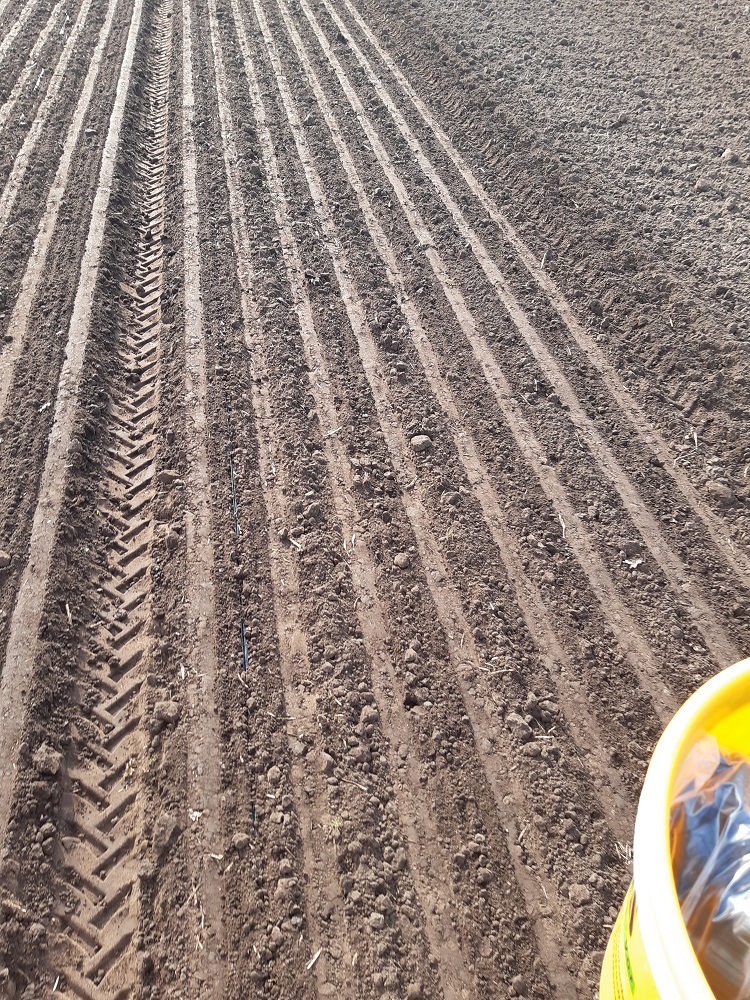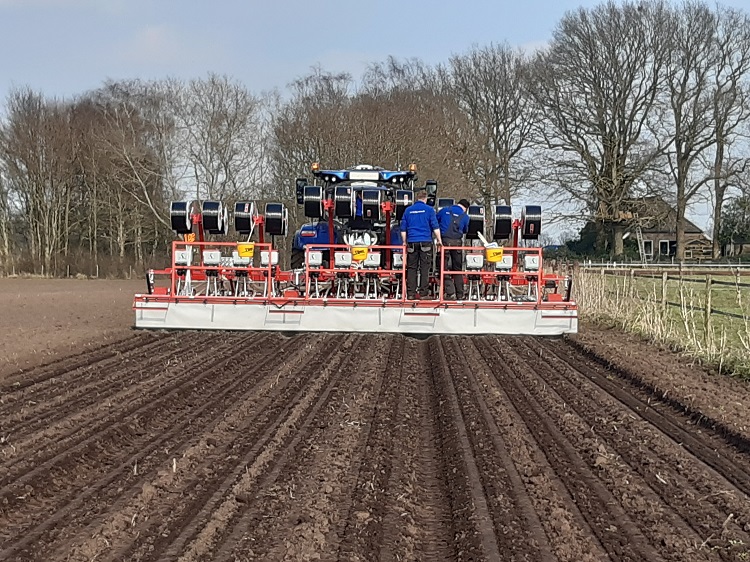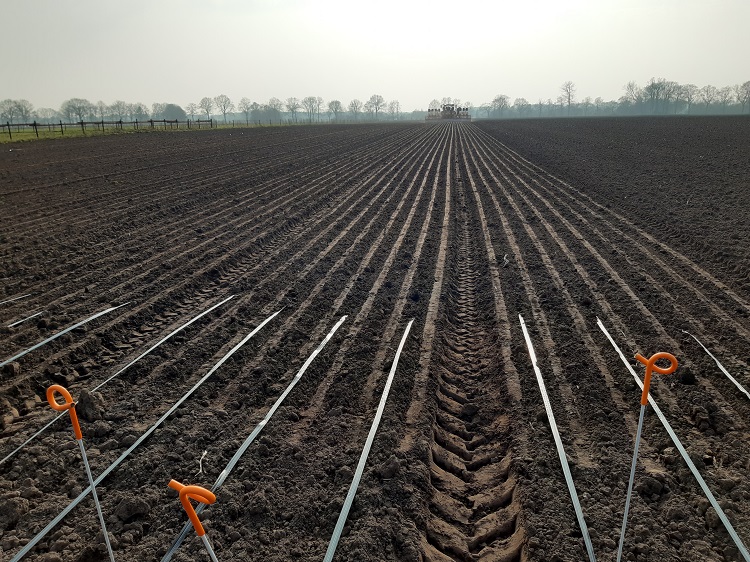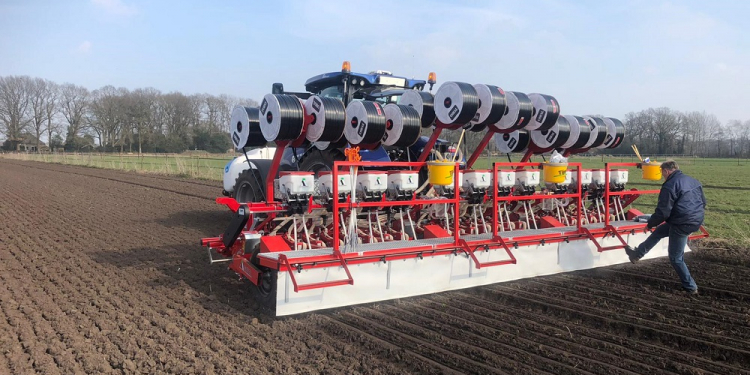Sow, apply drip tape and create an anti-dust cover in one pass. The first hectares with a prototype of this unique concept will soon be turned on the sandy soils of Drenthe. The predicted results are very hopeful. “There is no other way than that we are going to bring in extra revenue with this.”
“With the cultivation of onions on sandy soil you know one thing for sure, at some point you have to irrigate,” explains owner Cor Mechielsen of Loonbedrijf Gerrits in Zwinderen. The contractor thinks he has found a good solution to take onion cultivation on sandy soil to a higher level. The idea is to use the first seeder in Europe for the first time during the season, which sows in one pass, applies drip tape and applies an anti-drift cover. It concerns a prototype, yet to be developed, preceded by many hours at the drawing board and in the workshop at the Tijms mechanization company in Geesbrug.
Only keep the seed house
In fact, only the seed house of the brand new three-bed Agricola precision sower has been retained. The Italian machine will have a working width of 6.75 meters (three times a bed of 2.25 meters) with which eight rows can be placed sharply in one bed. Four rows of Toro AquaTraxx drip tape were applied between the rows in the first operation in each bed with cutting discs, followed by the onion seed. With the coulter, both the seed and the drip irrigation are covered with soil.

In the last operation, a starch emulsion, an anti-dust cover, was created with five nozzles per bed. This is a fully biodegradable adhesive based on modified starch from legumes. The fifteen nozzles will be placed on a bar with a platform on top where employees can stand or possibly extra rolls of drip tape.
The special seed drill is a new step in the development of drip irrigation. Using water sparingly is a challenge facing Dutch agriculture. Advancing salinization shows that the use of surface water cannot take place unbridled. “As a contractor I took over this company in Zwinderen two years ago. I have not been working on sand for very long, but that is a wonderful challenge. In those two years we have had a lot of drought. You then see the growers in full irrigation and then you start talking. Drip irrigation is one of the topics discussed ”, Mechielsen explains,
Water from wells
“We get most of the water here in the area from sources and even there, availability is increasingly an issue. When we talk about surface water, we see here and there that brown rot is a problem. These are all points that require us to use water more effectively. Soil is simply too expensive not to irrigate. We cannot afford a miscrop, but if you look at the high degree of evaporation during irrigation, we have to look at other solutions. ”
Drenthe irrigation project
The development of the seeder stems from the Self-Regulating Underground Watering System for Potato Yield Maximization (ZOBAM +) project in Drenthe and Groningen. “It is an irrigation concept in which we try to increase the maximum yields in potatoes,” explains Johan Tijms of Tijms Mechanisatie. “We are now also looking at other crops.” Temperature and moisture sensors are used to try to administer water as efficiently as possible. Various systems have been monitored throughout the entire process with temperature and moisture sensors in order to supply water to the potato plant as efficiently as possible. “We have to be more economical with the fresh water. This process ensures the right step in the right direction, ”says Tijms.

“It is often thought that drip irrigation is expensive,” says Gerard Schoot Uiterkamp of Toro importer Jean Heybroek. Once drip tape is in the ground, it gives a lot more rest. After all, you can quickly turn on the drip irrigation and add water at exactly the right time. It also provides much more certainty in the yield. Very interesting in combination with the application of fertilizers, or fertigation. ”
ZOBAM project
A subsidy is available for participants in the ZOBAM project, but a significant part is still borne by the farmer. “The subsidy is a bonus, but above all there must be a conviction that irrigation can and must be done differently,” says Johan Tijms, “When it comes to optimization in cultivation, this can be done in various ways. Someone else may see more in precision fertilization. I am convinced of specific area irrigation. Just like extinguishing a fire, it starts with water, the rest will come later. ”
According to Schoot Uiterkamp, ZOBAM started on a small scale, with a number of companies putting their heads together. “The small-scale has been finished. There are now several companies that are cooperating. Now we are going to work on a large scale. That is why it is now also the ZOBAM + project. The mechanization around driptape is an important factor in my opinion. ” The development of the special seed drill is a great step, although all participants realize that it is still pioneering. “Once the prototype has been developed and tested, the grinder will probably have to be used again to perfect the necessary things,” thinks contractor Mechielsen. Johan Tijms expects that too.

Onion cultivation to a higher level
The contractor sees great opportunities in the onions in particular. The onion area in Drenthe is growing rapidly. “Despite the fact that sand has its limitations, the soil here is clean. In Zeeland and the polders, people are increasingly encountering soil-related diseases. Growing sand is different, but we are making good progress. That starts with breeding. Varieties that deliver high quality. Fertilizers and crop protection are another. Agricultural wholesaler Johan Schuitema from Mussel is therefore also involved in the project. With RMA weather stations, we will look at the moisture content to which we also adjust the drip irrigation. ” The Northern Netherlands Agricultural Laboratory conducts all studies in terms of levels in the soil. “In this way, onion cultivation is lifted to a higher level together.”
The revolutionary seed drill is an important step, because the drip tape, seeding and anti-dust cover will be laid in one pass. A maximum of eight hundred meters of drip tape can be applied from the source. “Drip tape with a diameter of 22 millimeters is available for the long parcels. In most cases, 16 millimeters is sufficient, ”says Gerard Schoot Uiterkamp.
The seed drill will probably be hung by Mechielsen behind a New Holland T6.180, because the seed drill will be rigid. Not necessarily because of the horsepower, but mainly for the lifting capacity. In total, the seed drill will have a weight of approximately 6.5 tons. “The rolls of tape also weigh thirty kilos each. The tank in front for the starch emulsion will not be a luxury. ”
Uniform quality and increased yield
The participating parties expect uniform quality and considerable returns. “We have the option of installing a pump on a plot that works on solar energy. With a delivery of 0.3 liters per hour per drip point, little pressure will be required. Less pressure requires less pump power, so the largest pump we use will only require four kilowatts, ”says Johan Tijms. A solar-powered pump also saves diesel oil and thus a CO2 reduction. “It is not without reason that the authorities are watching closely.” The application of an anti-dust cover can also be an interesting addition. “It’s a gamble, but we believe in it. The starch emulsion is simply a syrup, which makes the sand heavier. After the first storm we saw that it works,
Biodegradable drip tape
A next step in drip irrigation may be a biodegradable drip tape. Schoot Uiterkamp: “Toro AquaTraxx is a hose made of polyethylene, a material that is easily recyclable and on which no residue can remain. Innovation continues. The development of drip irrigation can no longer be stopped. ”
This is an article from our Arable farming newspaper. De Akkerbouwkrant on the mat for free?









